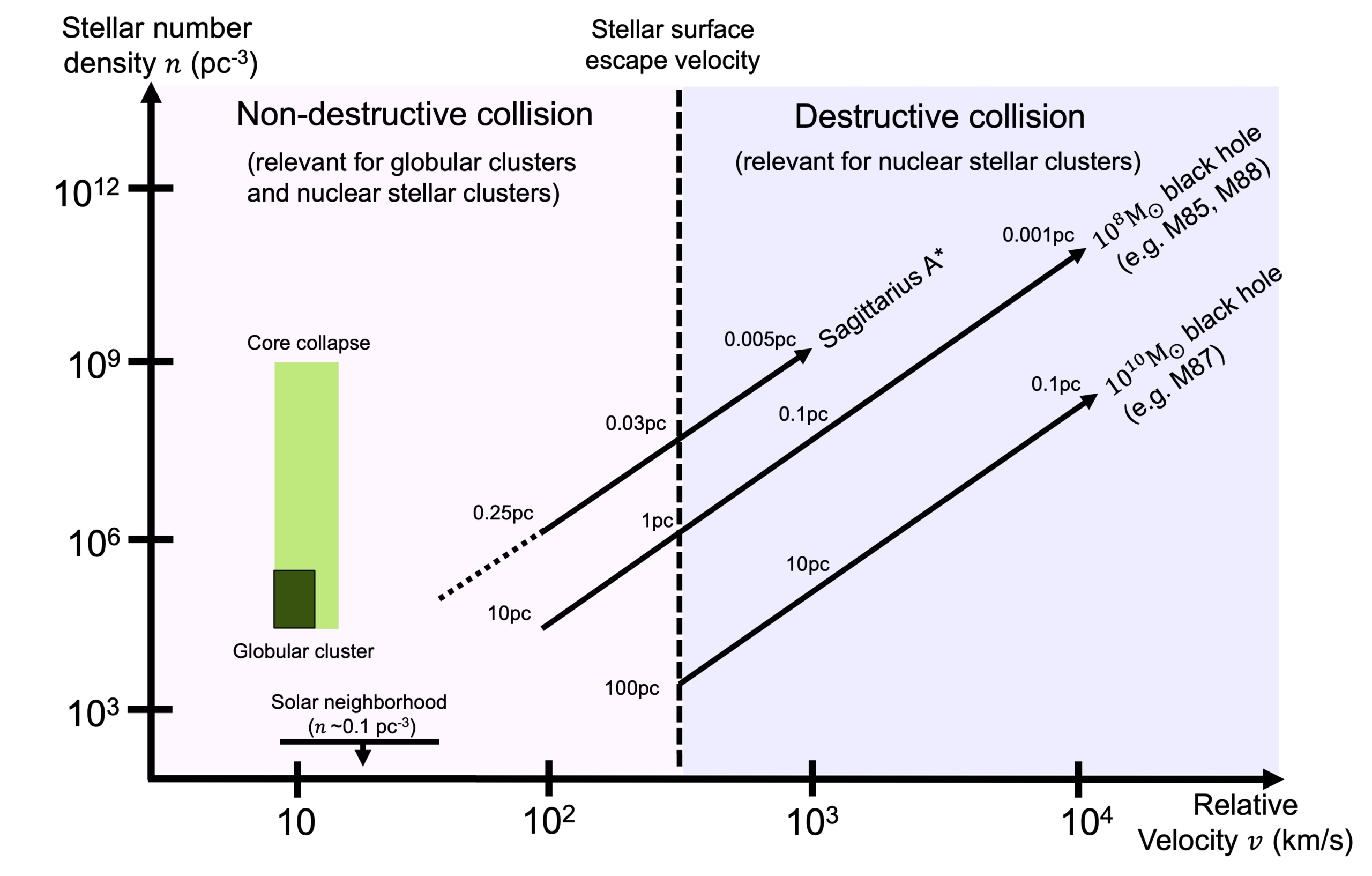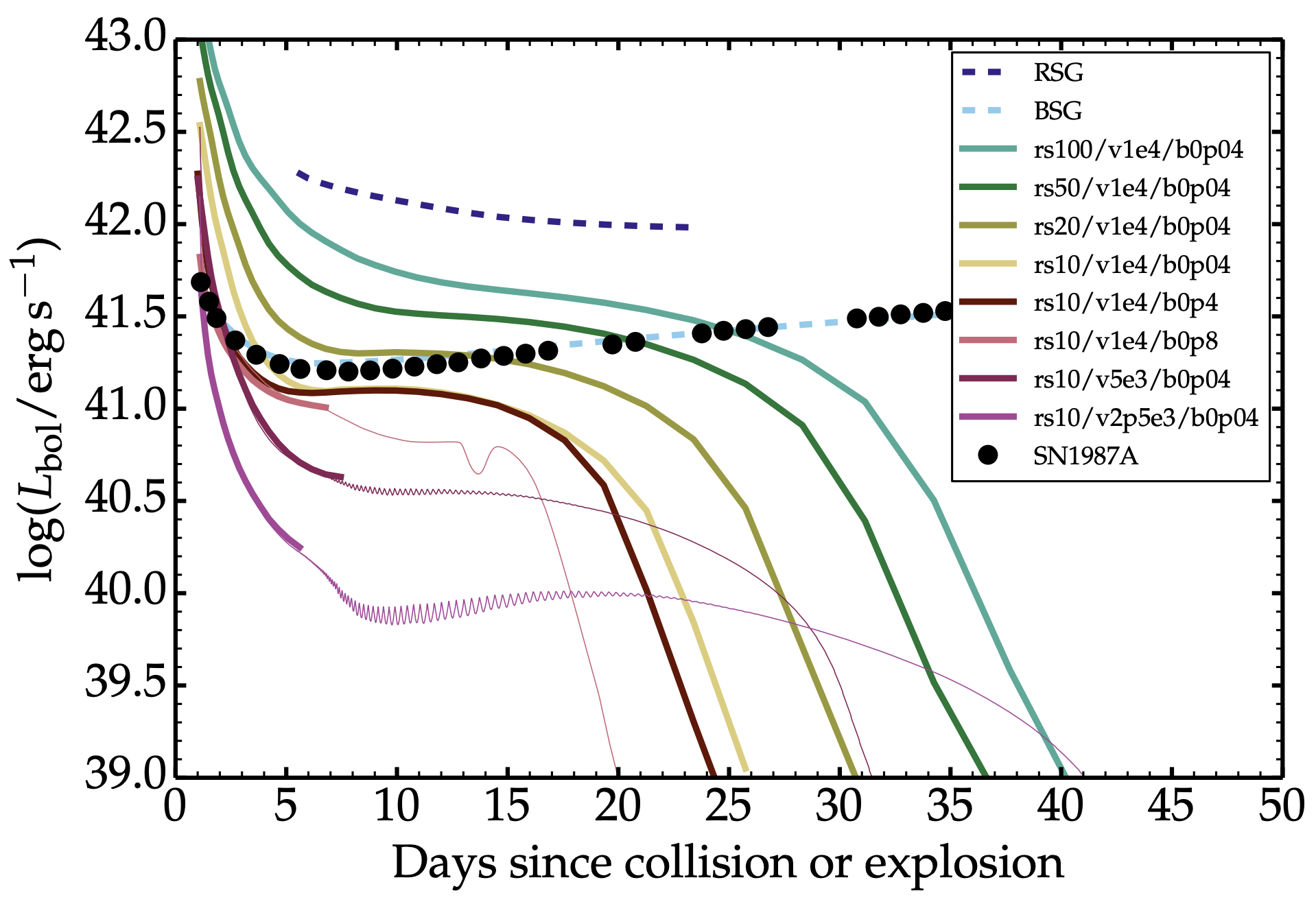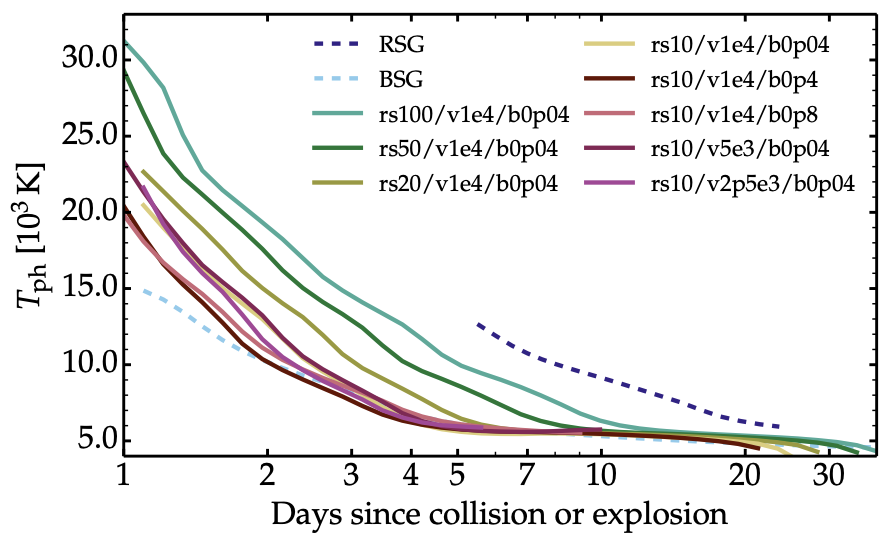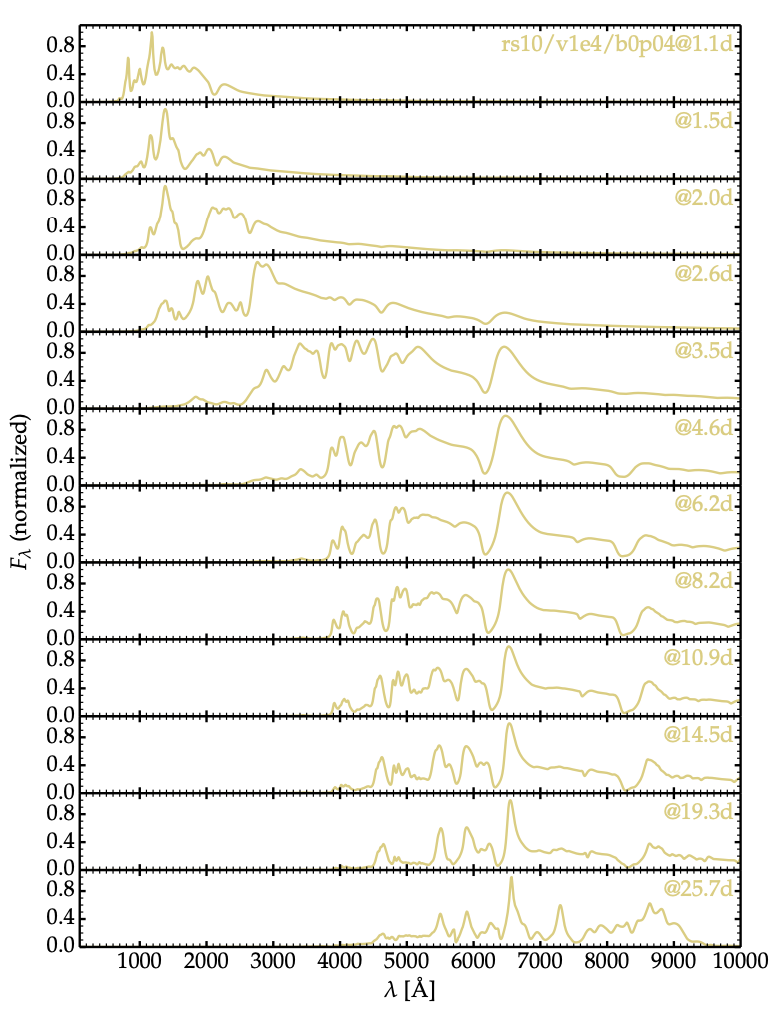Stars collide each other frequently in dense stellar environments, such as globular clusters and nuclear clusters. Depending on collision parameters (e.g., relative velocity, impact parameters, stellar mass, and stellar age), a variety of outcomes with unique observational signatures can be made.
One of the most important determining factor for outcomes is the kinetic energy of the collisions. To zeroth order, depending on whether the collision kinetic energy is greater than the binding energy of the colliding stars, the collisions can be non-destructive or destructive. If the collision kinetic energy ![]() is smaller than the stars’ binding energy
is smaller than the stars’ binding energy ![]() ,
,
(1) ![]()
the collision is non-destructive, meaning the two stars would merge into a more massive star. Because ![]() , where
, where ![]() is the stellar surface escape velocity, Equation 1 can be re-written as
is the stellar surface escape velocity, Equation 1 can be re-written as ![]() ,
, ![]() is the relative velocity between the two colliding stars. On the other hand, if the collision kinetic energy exceeds the stars’ binding energy,
is the relative velocity between the two colliding stars. On the other hand, if the collision kinetic energy exceeds the stars’ binding energy,
(2) ![]()
the collision can be destructive, meaning the collision can destroy either or both stars, leaving behind a stripped or no star. The figure below shows in which environments destructive and non-destructive collisions occur, as a function of stellar number density and relative velocity.
Of course, it is not so simple. While non-destructive collisions (![]() or
or ![]() ) are not actually destructive, not all collisions with
) are not actually destructive, not all collisions with ![]() or
or ![]() end up destroying stars, depending on the size ratio between the colliding stars and impact parameter. For example, if two stars with a contrast in size (equivalently in mass for main-sequence stars) collide, the smaller star would simply penetrate through the envelop of the larger star. So from now on, I will refer to the two types of collisions as ‘low-velocity’ and ‘high-velocity’ collisions. My collaborators and I are investigating the observational signatures and outcomes of both types of collisions using the two state-of-the-art codes MESA and AREPO.
end up destroying stars, depending on the size ratio between the colliding stars and impact parameter. For example, if two stars with a contrast in size (equivalently in mass for main-sequence stars) collide, the smaller star would simply penetrate through the envelop of the larger star. So from now on, I will refer to the two types of collisions as ‘low-velocity’ and ‘high-velocity’ collisions. My collaborators and I are investigating the observational signatures and outcomes of both types of collisions using the two state-of-the-art codes MESA and AREPO.
1. ‘low-velocity’ collisions
These collisions are not sufficiently energetic, so the two stars merge into a more massive star, rather than both stars being destroyed. Because of chemical mixing, heat injection, and rotation induced by collision, the collision products can manifest as blue stragglers – a group of stars that appear bluer and younger than their counterparts and are located differently from most cluster members on color-magnitude diagrams. Stellar collisions, facilitated by multi-body interactions involving binaries, may serve as the dominant formation channel for blue stragglers in dense clusters. These stars can provide unique information about the evolution history of clusters and stellar populations within them.
Collision products are out of thermal equilibrium upon collision and, therefore, they are swollen in size. In addition, unless the collision is perfectly head-on, the collision product contains angular momentum comparable to or possibly larger than the theoretical upper limit of the angular momentum for a normal star of the same mass. This naturally leads the collision product to lose a significant fraction of its mass and angular momentum during transition to a thermal equilibrium state, unless it spins down efficiently. This excessive angular momentum of the collision product posed an ‘angular momentum’ problem for the formation of blue stragglers (Sills et al. 2005), where if the collision product loses too much mass before it spins down, the outcome would have too low mass to appear as blue stragglers.
Consequently, whether collisions are a plausible mechanism for the formation of blue stragglers comes down to a key question: can the collision product spin down efficiently? While a few spin-down mechanisms have been proposed, most of them require the existence of magnetic fields within the star, such as magnetic braking. In addition to the direct impact of magnetic fields on the spin, it has been known that magnetic fields can also significantly affect the internal structure of the star, namely, the redistribution of angular momentum and chemical elements inside rotating stars, and, therefore, even their final fate. Despite the importance of magnetic fields, the magnetic field strength and configuration inside collision products remain highly uncertain and no work on this subject using magnetohydrodynamics simulations in the context of blue stragglers has been done in the last decade.
Recently, we investigated magnetic field amplifications using magnetohydrodynamics simulations and found that magnetic field energy is amplified by a factor of ![]() , independent of collision parameters!!! See the movies for density and magnetic field distribution in a collision between
, independent of collision parameters!!! See the movies for density and magnetic field distribution in a collision between ![]() M
M![]() and
and ![]() M
M![]() stars with an impact parameter of 50\% of the sum of stellar radii.
stars with an impact parameter of 50\% of the sum of stellar radii.
Please check out our paper for more results and see more movies here!
2. ‘high-velocity’ collisions
In this paper, we show that the outcome of the collisions is an homogolously, supersonically and quasi-spherically expanding gas cloud, generating a flare with peak luminosity as large as ![]() erg/s. Interestingly, a subsequent, possibly even brighter flare can be created by the interaction of the expanding gas cloud with a nearby black hole. The entire gas cloud can be gravitationally captured by the black hole and possibly accreted onto it. This could be a new venue for the growth of seed black holes. See our paper, which was chosen as a research highlight at MPA webpage!
erg/s. Interestingly, a subsequent, possibly even brighter flare can be created by the interaction of the expanding gas cloud with a nearby black hole. The entire gas cloud can be gravitationally captured by the black hole and possibly accreted onto it. This could be a new venue for the growth of seed black holes. See our paper, which was chosen as a research highlight at MPA webpage!
See the example movie showing a collision between ![]() M
M![]() giants (
giants (![]() R
R![]() ) at an initial approaching relative speed of
) at an initial approaching relative speed of ![]() km s
km s![]() . See more movies here.
. See more movies here.
As a follow-up, starting from a sample of red-giant star collisions simulated with the hydrodynamics code AREPO, Dessart, Ryu et al. (2023, submitted to A&A) generate photometric and spectroscopic observables using the nonlocal thermodynamic equilibrium time-dependent radiative transfer code CMFGEN. We show that collisions from more extended giants or stronger collisions (higher velocity or smaller impact parameter) yield bolometric luminosities on the order of ![]() erg/s at 1d, evolving on a timescale of a week to a bright plateau at ~
erg/s at 1d, evolving on a timescale of a week to a bright plateau at ~![]() erg/s, before plunging precipitously after 20-40 days at the end of the optically-thick phase. The figures below show the bolometric luminosity and blackbody radius for several collision models (solid color lines), including those for the blue super-giant (BSG) explosion model and the red super-giant (RSG) explosion model, and the inferred values for SN 1987A.
erg/s, before plunging precipitously after 20-40 days at the end of the optically-thick phase. The figures below show the bolometric luminosity and blackbody radius for several collision models (solid color lines), including those for the blue super-giant (BSG) explosion model and the red super-giant (RSG) explosion model, and the inferred values for SN 1987A.
This luminosity falls primarily in the UV in the first days, thus when it is at its maximum, and shifts to the optical thereafter. Collisions at lower velocity or from less extended stars produce ejecta that are fainter but may remain optically thick for up to 40 days if they have a small expansion rate. These collision debris show a similar spectral evolution as that observed or modeled for blue-supergiant star explosions of massive stars, differing only in the more rapid transition to the nebular phase. Such black hole-driven disruptive collisions should be detectable by high-cadence surveys in the UV like ULTRASAT.
The figure below shows the time evolution of spectra for the model for the head-on collision between ![]() R
R![]() giants with relative velocity of
giants with relative velocity of ![]() km s
km s![]() .
.




